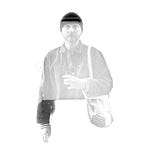À Beatty de souffle. Arthur Penn’s Mickey One.
Arthur Penn’s early collaboration with Warren Beatty, Mickey One, is overshadowed in the annals of film history by their later work on the zeitgeist setting Bonnie & Clyde, but in many ways this is the more interesting picture.
Open about his admiration for the French New Wave, Penn set out to make a film heavily informed by his Gallic influences. Disparagingly referred to as “Mickey One 1/2”, and written off as pretentious at the time, Penn’s film struggled with contemporary audiences, despite a solid credibility; the film was lensed by Bresson, Resnais and Chris Marker collaborator Ghislain Cloquet, and played at the 1965 edition of famously Europhile New York Film Festival alongside Jean-Luc Godard’s Alphaville and Michelangelo Antonioni’s La signora senza camelie.
A breakneck opening shows the film’s protagonist galavanting about town. There’s a mythic quality to these moments that brings to mind all kinds of things; Belmondo, Beat, Bond, and it’s all scored to a wild jazz soundtrack. The good times come to a halt with the immortal “The ride was over. I was trapped”, before fleeing to pastures new. It’s in this new world where we catch up with the man, thus far without a moniker but here renamed “Mickey One” (thanks to his stealing the identity of a down-and-out in the street). His arrival in this new city is greeted by an remarkable, downright apocalyptic sequence that takes place in a scrap yard, that verges on the operatic. Steel bends and fires burn, while Penn’s camera bounds and zooms about at an extraordinary rate. The film is an unexpectedly eye opening portrayal of mid-20th Century inner-city poverty, with its portrayal of an underclass not often seen through Hollywood cameras in the mid-1960s.
An emphasis on cultural ephemera and cinephilia, runs through the movie, much in the same way that similar things did in the Nouvelle Vague. “I’m the king of the silent pictures. I’m hiding out ’til the talkies blow over” barks Beatty in the direction of one inquisitive party, while a fight sequence is akin to something from a slapstick comedy. Bar signs, theatre neons and newspaper ads fill the screen, while one can’t help but see Club Xanadu and think of Orson Welles. The films aesthetic code feels genuinely unlike anything else in the American cinema of the time. Striking close-ups focus of an audience during a sequence in a striptease bar, while much of the picture is shot fast-cut and handheld. It’s oddly playful too, in spite of the woes being shown; a psychotic episode is interrupted by a sped-up comedic interlude, while slow motion trampolining and a Seussian contraption-come-art-installation are just some of the wonders seen along the way.
Paranoia undercuts the picture, with “Mickey” forever concerned with those he left behind alongside a debt and a roster of lovers in the town from which he fled (the film would come to serve as a fascinating ode to celebrity in the wider Beatty oeuvre), and it fells like something of a precursor to the much-lauded paranoia thrillers of the 1970s. One can’t help but think of John Cassavetes’ Killing Of A Chinese Bookie and Shadows, or the work of Jean-Pierre Melville. Welles’ noir-infused take on Kafka’s The Trial is another touchpoint too; our man owes a debt to someone, he’s sure, but he doesn’t know who, what or how to get around it.
